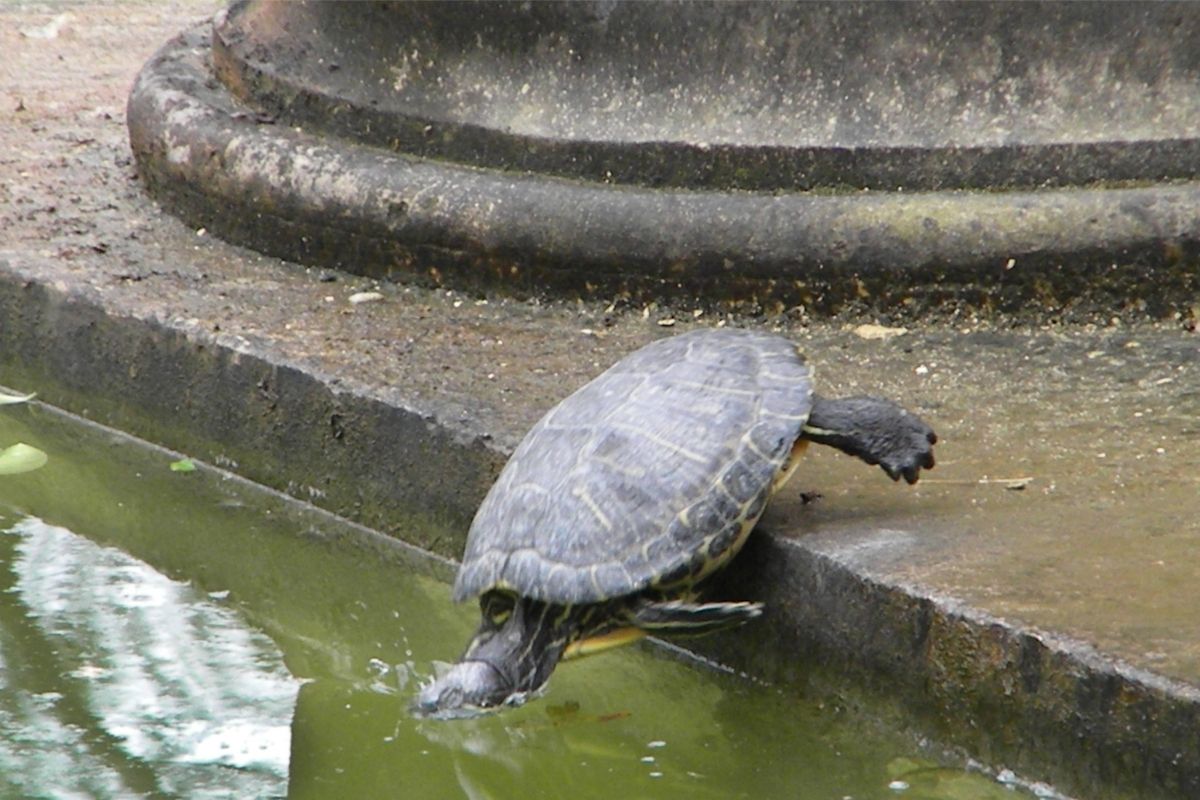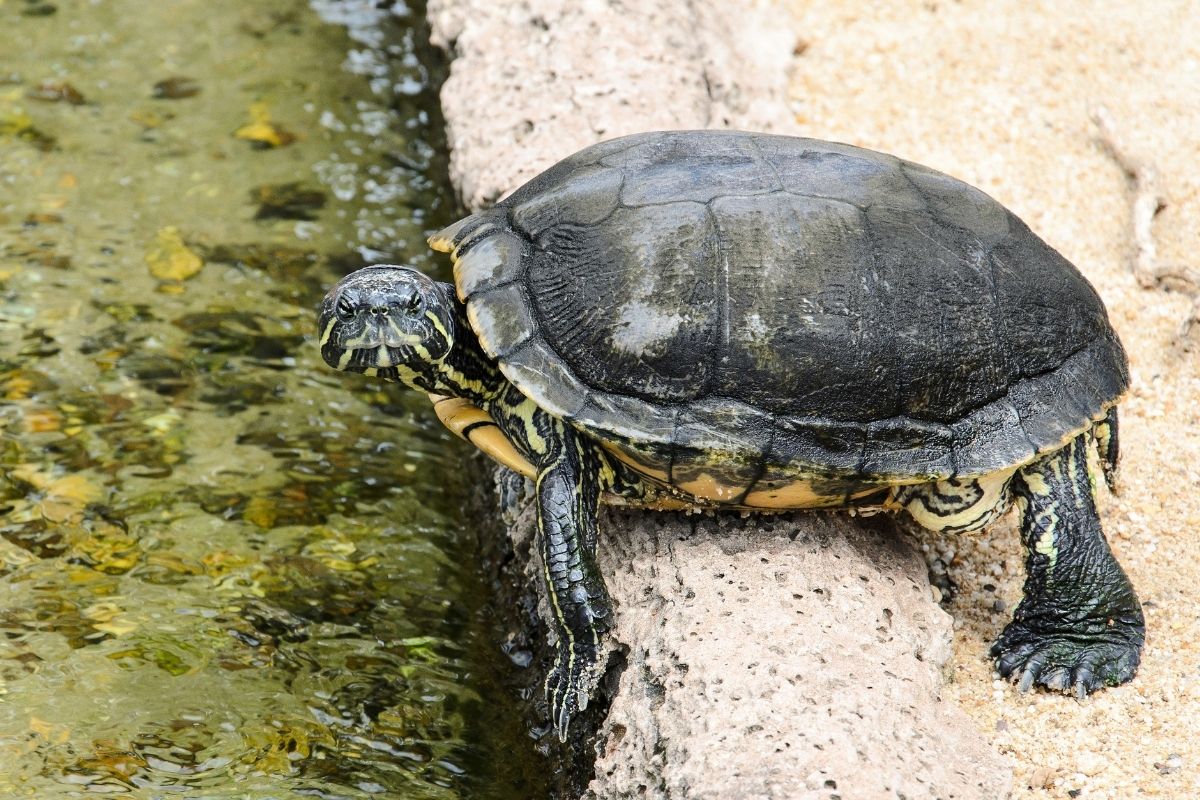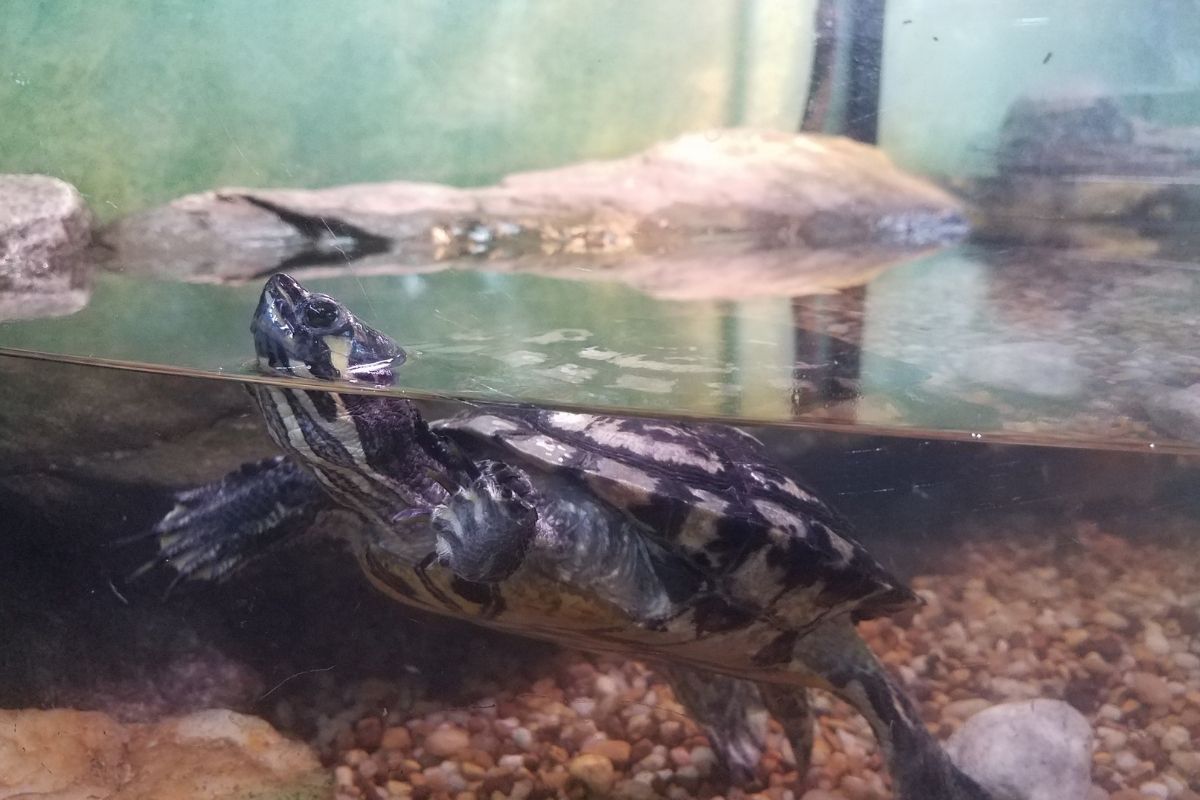Many people believe that turtles cannot jump due to the weight of their shell.
If you’re wondering whether turtles can jump, you’ve come to the right place.
In this article, I will cover some key information on a turtle’s ability to jump, including whether they can jump and why they jump.

Let’s get started.
Turtles are reptiles that belong to the order Testudines (turtles). They are characterized by having four legs and two shells.
The shell protects the turtle from predators and provides shelter. As amphibious animals, turtles are able to survive in both land and water.
Can Turtles Jump?
Turtles are amazing creatures. They live in water and spend their lives swimming around. But, can they jump?
Yes, when out of water, some turtles have the ability to jump. A variety of small and medium-sized turtles are able to jump forward. However, generally speaking, larger turtles don’t tend to jump.
However, due to their inflexible body and heavy shell, they don’t have the easiest time jumping. In addition to this, as they spend the majority of their time in water, they don’t jump very often.
What makes them able to jump? Physically, turtles have all that they need to jump. With four legs, and enough muscles to jump, turtles have the capability to jump.
What Factors Influence How A Turtle Jumps?
The main factors that influence how a turtle jumps are its legs and shell.
A Turtle’s Legs
Turtles are quadrupedal, meaning that they walk using all four feet. This also applies to them jumping. Humans, on the other hand, are bipedal, which means that we have two legs that we use to stand up.
As a result of this difference, a turtle’s weight is distributed differently than how it is for us humans.
Unlike us, the majority of a turtle’s weight is very close to the ground. In addition to this, turtles legs are very small in comparison to their bodies.
While this isn’t super handy when it comes to jumping, it doesn’t prohibit them as much as people think.
A Turtle’s Shell
The majority of people believe that a turtle’s shell is the heaviest part of them, and for this reason, they cannot jump.
However, this isn’t necessarily true. For the majority of turtles, the weight doesn’t represent the majority of their mass.
Even if a turtle’s shell covers most of their body, the shell isn’t heavy when compared to the muscles and organs inside the body of a turtle. For most turtles, the shell makes up around 20 to 45% of their entire body weight.
There are few turtles that grow so big that their shell makes it impossible for them to jump. For many turtles, such as red-eared turtles as well as snapping turtles, the shell is not that heavy when you compare it with the rest of the body.
How Does A Turtle Jump?

Turtles are unable to jump backward or sideways. They only jump forward. When a turtle jumps, it bends its back legs whilst also extending its front legs and keeping them slightly bent before propelling itself forward.
This is how many quadrupedal animals jump. However, turtles are not particularly flexible, which can add another layer to this challenge.
Due to the fact that they’re rather inflexible, the process of jumping is slightly trickier for them. However, this doesn’t mean that they can’t do it!
How Far Can Turtles Jump?
While turtles can jump, they aren’t able to jump long distances. Turtle species vary greatly in size, and the size of the turtle will depend on how far they can jump.
In terms of distance, the majority of medium-sized turtles have the ability to jump between 3 and 4 inches. On the other hand, smaller turtles such as box turtles can jump around 2 inches.
Due to the fact that a turtle’s jump is so short, their jump can resemble more of a hop.
This often causes people to refer to this action as hopping, as this is a better description of the behavior.
In addition to its size, another factor that determines the distance of a turtle’s jump is the pace. For instance, a turtle that is running before it jumps can usually achieve a longer distance than a turtle that jumps when it is stationary.
Why Do Turtles Jump?
Turtles live in and out of the water, meaning that they inhabit environments that are near water sources.
The primary reason for a turtle to jump is that they need to jump off boulders and rocks in order to reach the water. Typically speaking, a little thrust is enough to achieve this, which suits the turtle’s short jumping distance nicely.
In addition to this, there are a variety of other reasons why you might see a turtle jumping.
Other Reasons For Turtle’s Jumping
Protection
Turtles also sometimes jump when they feel scared or when they feel threatened in some way.
This is especially common for larger turtles who have a tendency to be territorial.
Stress
Some turtles jump when they experience stress. This includes when they are being chased by predators, when they are feeling trapped, or when they are experiencing pain.
In addition to this, if you have a pet turtle that shares a tank with others or the environment isn’t suitable, it could show its stress by jumping.
Avoiding Danger
When a turtle feels danger approaching, it may jump from a rock or boulder as a last resort in order to avoid being harmed.
It can sometimes be a calculated escape and at other times an instinctual reaction to a threat.
What Are Some Other Uses Of Turtles’ Jumping Ability?
Aside from using their jumping ability to get into the water, there are other ways that turtles use their jumping abilities.
For example, they can use their jumping ability to help them climb up trees and branches.
They can also use their jumping ability to defend themselves against predators.
However, one thing that should be noted is that while jumping is a great defense mechanism, it is not foolproof as turtles can only jump forwards. This is where their hard shell comes into play!
As a result, many adult turtles aren’t concerned about predators in that their hard shell serves as a self-defense mechanism in and of itself.
How To Stop A Turtle From Jumping In Captivity?

If you’ve noticed your pet turtle is jumping a lot in their tank, you might be concerned and want to know how to stop this behavior.
The good news is, jumping is natural. However, it’s also normal to worry when it comes to providing your turtle the best life possible.
So, what are a few things that you can do?
Control The Environment
If you’re worried about your turtle hurting itself by jumping off rocks that you’ve provided, then you can rearrange their tank and remove their need to jump.
This can include high rocks, or certain platforms that you think they could injure themselves on if they do decide to take a leap.
However, you will want to make sure that you do this with care and caution, as you don’t want to make their environment too dissimilar from what they’d experience in the wild.
To ensure that your turtle is happy as they can be in their environment, you will need to make sure that you’re regularly checking and maintaining their water conditions, tank size, and basking platforms.
Typically speaking, the water temperature should be between 75 and 86 degrees Fahrenheit. Any temperature outside of this parameter will likely begin to affect your turtle.
As a result, it’s essential to invest in a reliable thermometer in order to regularly check the temperature of their tank.
In addition to this, you will need to make sure that you regularly change their water and clean their tank.
However, it’s worth noting that this can stress your turtle out, so you will need to ensure that they have another secure area that they can be in whilst you are carrying out the clean.
Book A Trip To The Vet
You can book a trip to the vet to ensure that your turtle is healthy.
If your turtle has been showing signs of illness, or has recently begun jumping consistently and you can’t work out why, then taking them to the vet can give you a better idea.
Your vet will be able to offer their advice whilst also providing the reassurance that you need that nothing is seriously wrong with your pet turtle.
Make Sure Your Tank Is Clean And Suitable For Your Turtle
The wrong environment could be having a bigger effect on your turtle than you know.
For instance, if you’ve got other animals in their tank, this could be a stressor that is causing them to jump.
If you suspect this is the case, you will need to make sure that you adjust their environment accordingly to remove the stressor.
Can Turtles Swim?
It depends on the turtle! Many turtles have evolved over millions of years to become aquatic creatures. As such, they are very well adapted for swimming, but they still require a solid substrate to rest upon.
In fact, most turtles prefer to stay near the bottom of their tanks, as they find it easier to breathe there.
As a result, you’ll want to provide them with a suitable platform that allows them to safely rest on top of the water.
Furthermore, you may want to consider adding some gravel to their tank to help them feel more comfortable when resting on the bottom.
Conclusion
Many small and medium sized turtles have the ability to jump, whether they live in the wild or in captivity.
Hopefully after reading this article you have a better understanding of how, why, and how far turtles can jump!
While this behavior is natural, if you’re concerned about your turtle recently beginning to jump, it’s best to take them for a veterinary check up.
Good luck taking care of your pet turtle!
